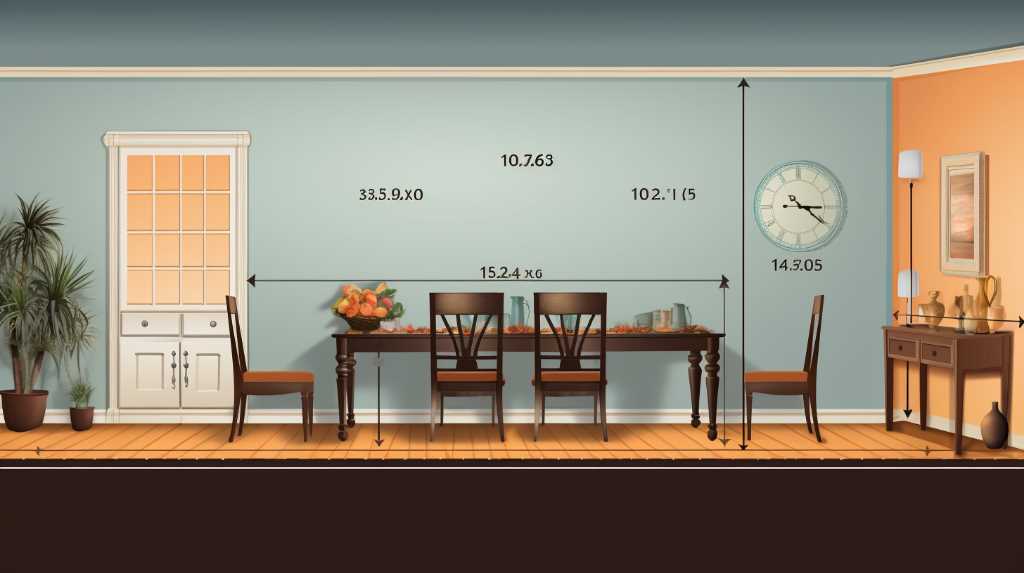
Setting up the perfect dining room layout requires thoughtful consideration and attention to detail. It’s akin to solving a puzzle, where each piece must fit perfectly.
Key aspects to keep in mind include accurately measuring the dining space and choosing a suitable table size. Additionally, ensuring ample chair clearance, maintaining balance with a sideboard or buffet, and harmonizing with the room’s natural flow are all crucial factors in creating an inviting and practical dining area.
By taking these considerations into account, you can craft a dining room layout that not only boasts an appealing look but also enhances the overall dining experience for both you and your guests.
Measuring the Dining Space

When measuring your dining space, it’s important to accurately measure the length, width, and height of the room to effectively plan your layout. This step is crucial in creating a dining area that’s both functional and aesthetically pleasing.
Consider the available lighting options, as they can significantly influence the ambiance of the room. Whether it’s a statement chandelier, pendant lights, or recessed lighting, the right choice can enhance the entire space.
Additionally, think about the decor styles you want to incorporate. From modern and minimalist to traditional and rustic, your decor style will set the tone for the entire dining experience.
Selecting the Appropriate Table Size

Selecting the Right Table Size for Your Dining Space
When it comes to creating a well-proportioned dining area, it’s crucial to start by measuring the dimensions of the room. Afterward, choose a table size that not only meets your needs but also complements the overall layout.
Consider the shape of the table and the seating arrangement when making your selection. For a more intimate setting, a round table is a great choice as it encourages conversation and works well in smaller spaces. On the other hand, if you prefer a more formal look or have a larger dining area, a rectangular or oval table might be more suitable.
Additionally, it’s important to consider the seating arrangement. Make sure to allow at least 24 inches of table width for each person, and ensure there’s enough space between the table and the walls or other furniture.
Taking these factors into account will help you choose a table size that sets the perfect ambiance for your dining room.
Ensuring Adequate Chair Clearance

Ensuring Adequate Chair Clearance
When setting up your dining room, it’s important to ensure there’s enough space around the table for comfortable movement and seating. To achieve this, leave at least 24 inches between each chair. This allows guests to sit down and stand up without feeling crowded.
Adequate clearance not only makes it easier to move around but also contributes to a visually balanced and uncluttered dining area.
It’s also essential to consider the seating capacity of the room. Make sure there’s ample room for each chair to be pulled out comfortably, allowing guests to sit and get up without any difficulty.
Balancing With Sideboard or Buffet

When arranging your dining room, a sideboard or buffet can be a practical and stylish addition. This piece of furniture not only serves as a focal point but also offers storage for tableware and linens.
When organizing the sideboard, consider using trays or baskets for smaller items like napkin rings, candles, or coasters. Drawers can be used to store table linens, placemats, and dining utensils.
When placing the buffet, ensure that it complements the dining table without blocking the flow of traffic. Keep in mind that the height of the sideboard shouldn’t overpower the room, and its length should be proportionate to the wall it rests against.
A well-placed sideboard or buffet can enhance the visual appeal of the dining room while also adding functionality and organization.
Aligning With Natural Room Flow

When arranging the layout of your dining room, it’s essential to ensure that the dining table and chairs are positioned to allow easy movement around them, flowing naturally with the room. Take into consideration the natural lighting and how it interacts with the placement of your dining table.
Placing the table near windows can create a warm and inviting atmosphere, enhancing the overall dining experience. Additionally, consider the traffic flow within the room and avoid placing the dining table in a pathway that disrupts the natural movement around the space. Opt for a layout that allows for seamless navigation to and from the dining area.

